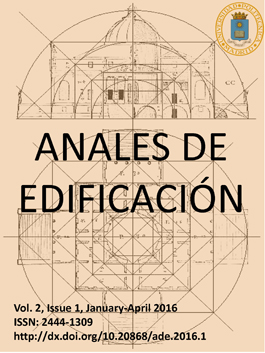Mejora del rendimiento térmico de los edificios históricos "difíciles de tratar" en el centro de Edimburgo = Improving The Thermal Performance of "Hard-to-Treat" Historic Buildings in Edinburgh’s New Town.
DOI:
https://doi.org/10.20868/ade.2016.3195Palabras clave:
Biomateriales compuestos, fibras naturales, pultrusión, perfiles, envolvente del edificio, Energy efficiency, conservation, refurbishment, historic buildings.Resumen
Resumen
Compuestos alternativos en el sector de la envolvente se obtienen por extrusión de estirado de secciones y perfiles de panel de enclavamiento estrechas. Estos elementos estructurales, resistentes al impacto, tienen la ventaja de una instalación más rápida y segura, y su diseño modular les hace idóneos para muchos edificios y otras aplicaciones. Un desarrollo adicional en esta área puede ser la obtención de una alternativa sostenible a los perfiles compuestos actuales. Estudios anteriores han demostrado que los compuestos fabricados a partir de materiales naturales tales como fibras y polímeros bio-derivados, ofrecen una alternativa sostenible a los polímeros y materiales compuestos tradicionales. El objetivo de este desarrollo es reemplazar el típico perfil de acero ligero. Los perfiles de acabado también se pueden utilizar para terminar tabiques de mampostería existentes, revestimiento de ejes mecánicos y de extracción y revestimiento de la columna. Los perfiles se han diseñado utilizando bio-polímeros, reforzados con fibras naturales. Se han establecido los parámetros de procesamiento y las formulaciones apropiadas de bioresina y fibras naturales. También se ha evaluado la adaptación de las técnicas de procesamiento de pultrusión existentes a las características concretas de los nuevos biomateriales y fibras naturales. Como resultado, los perfiles de pultrusión adaptados a la construcción se han desarrollado con la incorporación de nuevos materiales y biomateriales basados en resina.
Abstract
This paper documents an innovative partnership project between Historic Scotland, the Scottish Energy Centre at Edinburgh Napier University and Castle Rock Edinvar Housing Association in which five Category B Listed, traditional pre-1919, solid wall ‘hard-to-treat’ residential tenement properties located within Edinburgh’s historic UNESCO World Heritage site each received energy efficient upgrades to walls and windows. A variety of measures were tested, achieving significant reductions in fabric heat loss without impacting upon the character and appearance of the buildings. The project is significant in that the energy-efficient upgrades all met with strict conservation requirements on alterations to Listed Buildings and have the potential to be replicated in similar properties throughout Scotland. The project won the award for best refurbishment project at the Carbon Trust’s Low Carbon Building Awards in 2012. All of the properties featured in this study are occupied by tenants within the social-rented sector who prior to the study had indicated some thermal discomfort due to poor window conditions and high heat loss through walls causing increase fuel consumption. The occupants all remained in their homes during the refurbishment activities.
Descargas
Referencias
Baker, P. (2008) Historic Scotland Technical Paper 2: In situ U-value measurements in traditional buildings: preliminary results, Historic Scotland, Edinburgh
Baker, P. (2011) Historic Scotland Technical per 10: U-values and traditional buildings: in situ measurements and their comparisons to calculated values, Historic Scotland, Edinburgh
Boardman, B. (2007) Home Truths: A low-carbon strategy to reduce UK housing emissions by 80% by 2050. Oxford’s Environmental Change Institute. A research report for The Co-operative Bank and Friends of the Earth, University of Oxford.
BS EN ISO 7345:1996: Thermal insulation: physical quantities and definitions. (Identical with 1987 ed.) London: BSI.
BS ISO 9869-1:2014 Thermal insulation, Building elements, In-situ measurement of thermal resistance and thermal transmittance - Part 1: Heat flow meter method. London: BSI
Changeworks (2008) Energy Heritage: A guide to improving energy efficiency in traditional and historic homes. Edinburgh, Changeworks Resources for Life.
ISO/DIS 9869-1:1994 Thermal insulation, Building elements, In-situ measurement of thermal resistance and thermal transmittance - Part 1: Heat flow metermethod. London: BSI
Historic Scotland (2015) Listed Building definitions and data. Available at: http://www.historic-scotland.gov.uk/ index/heritage/historicandlistedbuildings/listing.htm
Rye, C. (2011) U-value report (SPAB Research Report, revised edition), SPAB, London
The Scottish Government (2002) Scottish Fuel Poverty Statement, Scottish Government, Edinburgh. Available at: http://www.gov.scot/Resource/Doc/46951/ 0031675.pdf
The Scottish Government (2009) Climate Change (Scotland) Act 2009. Crown Copyright 2009, Scotland, UK.
The Scottish Government (2013a) Scottish House Condition Survey – Key Findings 2013, Scottish Government, Edinburgh. Available at: http://www.gov.scot/ Resource/0046/00465627.pdf
The Scottish Government (2013b) Low Carbon Scotland: Meeting our Emissions Reduction Targets 2013-2027: RPP2. Edinburgh.
Utley, J.I. & Shorrock, L.D. (2008) Domestic energy fact file 2008. London.
Descargas
Publicado
Número
Sección
Licencia
1. Los autores conservan los derechos de autor y garantizan a la revista el derecho de una Licencia Creative Commons Atribución - Nocomercial 4.0 Internacional que permite a otros compartir el trabajo con un reconocimiento de la autoría y uso no comercial.
2. Los autores pueden establecer por separado acuerdos adicionales para la distribución no exclusiva de la versión de la obra publicada en la revista (por ejemplo, situarlo en un repositorio institucional o publicarlo en un libro).
Salvo indicación contraria, todos los contenidos de la edición electrónica se distribuyen bajo una licencia de uso y distribución “Creative Commons"












